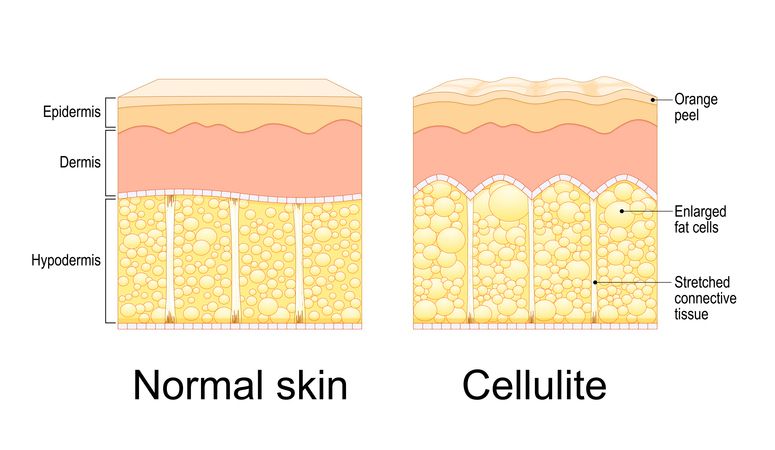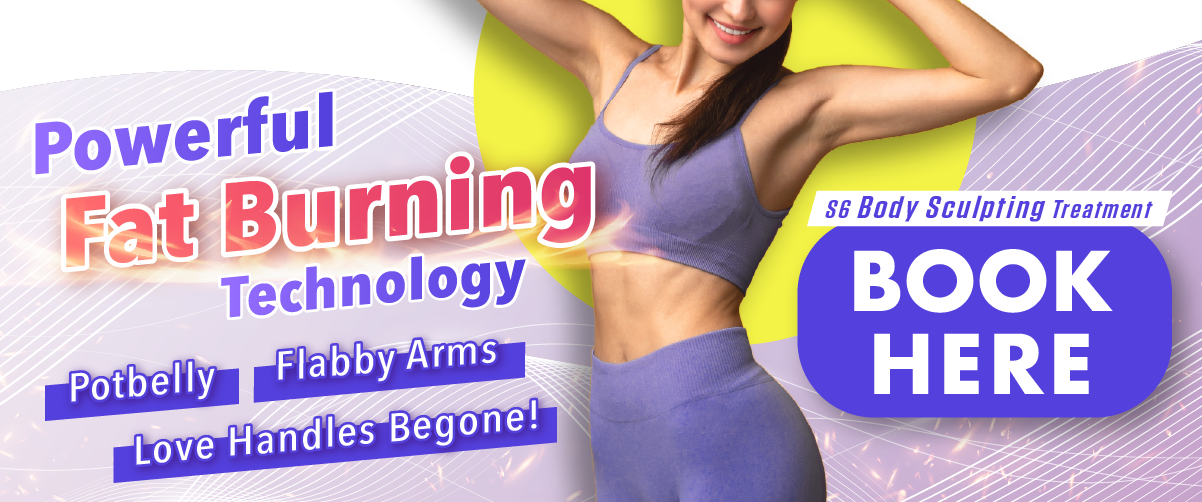
Author: Natalie Ng|Updated: 7 May 2025
Trying to slim down your inner thighs can feel frustrating—especially when stubborn inner thigh fat doesn’t seem to budge, no matter how active you are. Thigh fat accumulation is one of those things that can sneak up on you over time, whether it’s from hormonal changes, weight gain, or just the way your body stores fat. And when that excess inner thigh fat starts to affect how your jeans fit or your confidence in shorts, it’s totally valid to want to do something about it. The inner thigh area is a common spot for the body to store subcutaneous fat, and while there's no magic trick to instantly reduce thigh fat, there are smart, effective ways to approach it. You’ll need more than just a few thigh exercises to get real results—it’s about shifting your whole approach to movement, eating, and how you take care of your body overall. In this guide, we’re breaking down effective strategies to help you target inner thigh fat in a way that supports healthy weight loss, builds strong thigh muscles, and leads to long-term results. Keep reading for the realistic, non-gimmicky tips that actually work.

Causes Of Inner Thigh Fat Storage
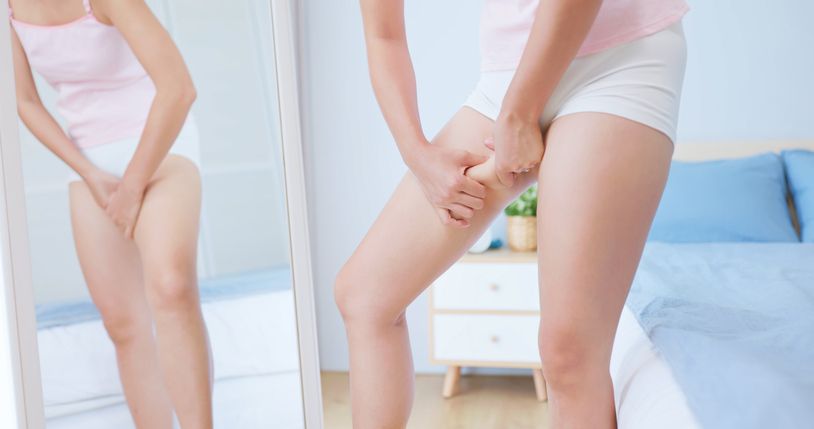
Why Inner Thigh Fat Accumulates
Inner thigh fat accumulation isn’t just about inactivity—it’s shaped by how your body functions on a deeper level. Fat accumulation occurs due to an energy imbalance where calorie intake surpasses calorie expenditure, leading to the storage of surplus energy as fat. Fat storage patterns are influenced by hormones, genetics, how many calories you eat, and how your body burns them. While some people store more fat in the upper body, others—especially women—naturally store more in the thighs and hips. This is part of your body’s built-in system for managing energy and reproduction.
Inner thigh fat refers to subcutaneous fat that builds up under the skin in the inner thigh area. Over time, excess inner thigh fat can lead to changes in the appearance of your legs and may affect how your clothes fit or how comfortable you feel during movement.
Hormones Play a Key Role
Estrogen is a major factor in thigh fat accumulation. It signals the body to store fat in the lower body—including the thighs and hips—as part of a reproductive function. This is why many women experience fat accumulation in these areas, especially during puberty, pregnancy, and even perimenopause.
• High estrogen levels often lead to more body fat stored in the inner thighs
• Fluctuations in estrogen can increase thigh circumference during certain life stages
• Low estrogen after menopause may shift fat storage toward the belly, but inner thigh fat often remains stubborn
Cortisol, the stress hormone, also contributes to fat retention. When your cortisol levels are high—due to chronic stress or poor sleep—your body is more likely to hold on to fat in survival zones like the thighs and abdomen. Insufficient sleep can lead to hormonal imbalances and increased fat storage, making it crucial to get enough sleep for better fat loss outcomes.
• High cortisol disrupts metabolism and increases fat storage
• It can lead to more cravings and less effective fat-burning
• Chronic stress makes it harder to lose inner thigh fat
Another important hormone group is your thyroid hormones. These regulate your metabolism—how your body uses calories and burns fat.
• Slow thyroid function (hypothyroidism) can cause weight gain and fat storage in the lower body
• Thyroid hormone imbalances may slow down the fat loss process, even with diet and exercise
• T3 and T4 hormones influence how efficiently fat cells are broken down
Genetics and Body Shape
Genetic factors help determine your body shape and how your fat is distributed. If your family tends to store fat in the lower body, chances are you will too. That’s why some people naturally accumulate fat in the inner and outer thighs, while others store it in the stomach or upper arms.
This doesn’t mean fat loss is impossible—it just means your body will lose fat in a pattern that’s based on your genes. Consistent workouts and a balanced diet can still help you lose thigh fat, but patience is key.
A Caloric Surplus Leads to Fat Growth
Your body stores fat when you consume more calories than you burn. This extra energy gets stored in fat cells, which grow larger—especially in areas where your body tends to store fat, like the thighs.
• A surplus of calories leads to fat accumulation
• Inner thigh fat grows as fat cells expand
• This process is reversible by maintaining a consistent calorie deficit
When your metabolism slows—due to age, hormones, or lifestyle—it becomes easier for the body to store excess calories as fat.
Fat Shrinks With Overall Loss, Not Spot Targeting
One of the biggest myths in fitness is that you can “spot reduce” fat. Doing inner thigh exercises won’t directly burn fat in that area. What it will do is build strength and improve tone in your thigh muscles.
Fat loss happens across your entire body. As your overall body fat decreases through consistent cardio, strength training, and proper nutrition, the fat stored in your thighs will gradually shrink. Your inner thigh muscles become more defined, and the shape of your legs improves over time.

Common Mistakes to Avoid When Targeting Thigh Fat
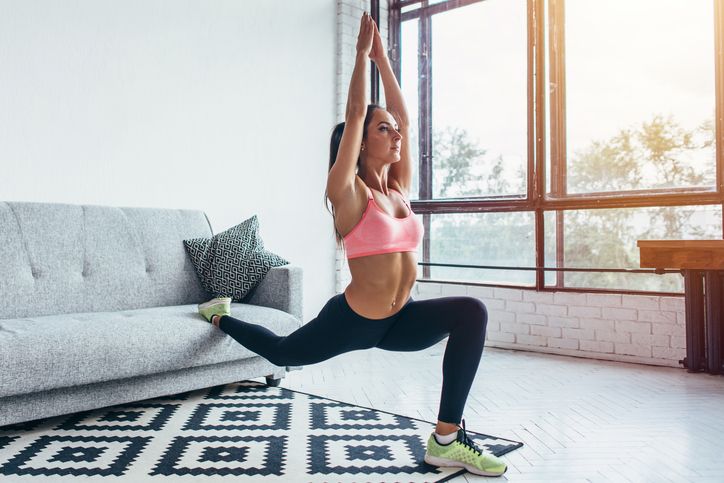
Many people struggle with thigh fat because of the same repeated mistakes. These errors can slow down progress, lead to frustration, or even cause muscle loss instead of fat loss. Understanding what not to do is just as important as knowing the best methods to reduce inner thigh fat. Incorporating a structured exercise routine that includes strength training and targeted exercises is crucial for achieving weight loss goals and improving overall health and fitness.
Thigh fat accumulation happens over time, and removing it requires a balanced, long-term approach. Avoiding these common pitfalls will help you see more consistent, realistic progress toward leaner, stronger thighs.
Mistake 1: Only Doing Inner Thigh Exercises
Some believe that doing lots of inner thigh exercises—like leg lifts or squeezes—will directly burn fat in that area. But fat loss doesn’t work that way.
• Targeted weight loss (spot reduction) is a myth
• You need to reduce overall body fat to lose fat in specific areas like the thighs
• Inner thigh exercises build muscle, but they won’t shrink fat without a full-body strategy
Mistake 2: Skipping Strength Training
Avoiding strength training out of fear it will “bulk up” your thighs is a mistake. Strength training actually helps you build lean muscle, improve body composition, and support fat loss.
• Lean muscle increases metabolism, which helps burn more calories
• Strength training helps shape the inner thigh muscles
• Avoiding it can slow down fat loss and make legs appear less toned
Mistake 3: Overdoing Cardio
Too much cardio and not enough resistance training can lead to muscle breakdown. You might lose weight, but not in a way that improves the shape or firmness of your thighs.
• Excessive cardio can reduce muscle mass
• This can slow metabolism and lead to fat gain later
• A mix of cardio and strength training leads to better long-term fat loss
Mistake 4: Following Crash Diets
Healthy weight loss requires a comprehensive approach, including targeted exercises, a balanced diet, and lifestyle improvements. Very low-calorie diets may cause quick weight loss, but they also reduce muscle mass and can lead to rebound weight gain.
• Crash dieting slows metabolism
• It often results in temporary fat loss with long-term fat storage
• It can also cause hormonal imbalances that worsen fat retention in the thighs
Mistake 5: Ignoring Protein Intake
Reducing calories without keeping enough protein in your diet can lead to muscle loss. This affects how your body burns fat and shapes your thighs.
• Protein helps maintain lean muscle while losing weight
• Low protein intake can slow recovery and reduce muscle tone
• Prioritize nutrient-dense foods with balanced macronutrients
Avoiding these mistakes can make a major difference in your ability to reduce thigh fat and strengthen the inner thigh muscles. The goal is a realistic, balanced plan—not a quick fix.
Book Now to Experience
S6 Body Sculpting Treatment
1 Minute Self-Registration
Date should not be before minimal date

Effective Ways to Target Inner Thigh Fat
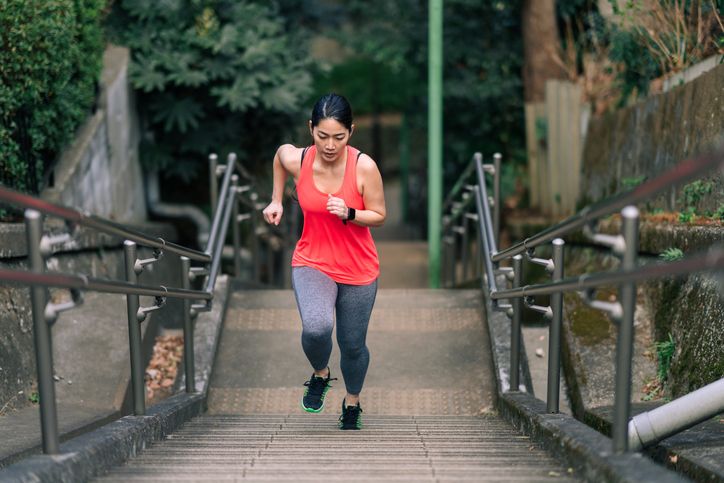
1. Essential Cardio Workouts for Thigh Fat Reduction
Why Cardio Helps Burn Thigh Fat
Reducing inner thigh fat starts with lowering your overall body fat. Cardio workouts are one of the most effective ways to do this. They increase your heart rate, which helps your body burn more calories. When you burn more calories than you consume, your body starts using stored fat—like that in the thigh area—as energy.
Even though you can’t target fat loss in just one area, consistent cardio supports fat loss across your entire body, including your thighs. Over time, this helps reduce stubborn inner thigh fat and improve your overall body composition.
Best Types of Cardio for Thigh Fat Reduction
Different forms of cardio activate different muscle groups. For thigh fat removal, you’ll want to include activities that engage your lower body and boost your heart rate.
Running
Running activates your entire lower body and helps strengthen the thigh muscles, especially when you include uphill routes or sprints. It’s a solid option for burning calories and reducing thigh fat accumulation.
Cycling
Cycling—whether outdoors or on a stationary bike—directly targets the thighs and calves. Pedaling builds muscle endurance in your legs while encouraging the body to use excess fat as fuel.
Swimming
Swimming offers a low-impact option that engages both the upper and lower body. It tones your legs, strengthens thigh muscles, and supports fat loss without stressing your joints.
High-Intensity Interval Training (HIIT)
HIIT alternates between short bursts of intense effort and brief rest periods. For example, you might sprint for 30 seconds, then walk for 1 minute. This type of training is efficient for fat loss, improves metabolism, and continues burning calories even after the workout ends. Incorporating walking lunges into your HIIT routine can further enhance muscle toning and body contour.
How Often to Do Cardio for Results
Aim for cardio 4–5 times per week. Each session should last at least 30 minutes to allow your body to enter fat-burning mode. You can mix steady-state cardio (like a 45-minute brisk walk or jog) with HIIT sessions to keep your workouts effective and varied.
To maximize results and help reduce inner thigh fat, add exercises like stair climbing, jump rope, and incline walking. These activities increase activation in the thigh area and improve lower body endurance.
2. Strength Training Exercises to Target Inner Thighs
Why Strength Training Matters for Thigh Fat
Cardio burns calories, but strength training shapes your muscles and improves body composition. If your goal is to reduce inner thigh fat and improve definition, strength training is essential. It helps you build lean muscle, which increases how many calories your body burns at rest. This supports overall fat loss while tightening the thigh area, leading to a more toned appearance.
When you strengthen the inner thigh muscles—especially the adductors—you create a firmer, more toned look. It also helps reduce the appearance of excess fat and improves balance and lower body strength.
Focus on the Right Inner Thigh Exercises
Choosing the right exercises helps ensure you're targeting the correct muscles. These movements focus on engaging the inner thighs through different ranges of motion and types of resistance.
1. Sumo Squat Variations
Sumo squats are a strong foundation for inner thigh training. The wide stance and foot position shift more work to the adductors than standard squats.
How to Perform
• Stand with feet wider than shoulder-width apart, toes turned outward.
• Lower into a squat while keeping your chest up and knees in line with your toes.
• Push through your heels to return to standing.
Try These Variations
• Pulsing sumo squats: At the bottom of the squat, pulse up and down 2–3 inches without standing all the way up.
• Jump sumo squats: Add a jump at the top of each rep to activate fast-twitch muscle fibers.
• Weighted sumo squats: Hold a dumbbell or kettlebell in front of your chest for added resistance.
• Banded sumo squats: Use a resistance band above the knees to increase inner thigh tension.
2. Inner Thigh Resistance Band Work
Resistance bands help maintain muscle engagement throughout each movement. They’re a great way to build strength in the inner thighs without needing weights.
How to Perform
• Place a looped resistance band around your thighs or ankles.
• From a standing position, take a slow step to one side, then return to center.
• Keep your core tight and knees slightly bent.
You can also sit with your knees bent and feet flat. Push your knees outward against the band's resistance, then bring them slowly back together.
3. Side-Lying Leg Lifts
This simple exercise targets the inner thighs directly and is easy to add to any workout routine.
How to Perform
• Lie on your side with your body straight and your bottom leg extended.
• Keep your top leg bent and resting on the floor for stability.
• Lift your bottom leg slowly, then lower it with control.
Keep your movements small and precise. Aim for 3 sets of 12–15 reps per leg, pausing briefly at the top to maintain tension in the thigh muscles.
When done consistently, these exercises will help strengthen the inner thigh area, reduce fat accumulation, and contribute to leaner, more defined legs.
3. Nutrition Strategies for Leaner Legs
Why Diet Matters for Thigh Fat
Exercise alone isn’t enough to lose inner thigh fat. To change how your body stores fat, you need to create a calorie deficit—burning more calories than you consume. This forces your body to tap into stored fat, including the fat cells in the inner thigh area.
At the same time, your diet needs to support muscle maintenance. If you cut calories too aggressively or eat too little protein, your body may break down muscle instead of fat. This can slow your metabolism and make it harder to reduce thigh fat effectively.
Build a Balanced Diet to Support Fat Loss
A smart, structured eating plan that emphasizes a healthy diet, rich in fruits and vegetables while avoiding processed sugars and fats, helps reduce body fat, including stubborn fat in specific areas such as the inner thighs, while keeping your energy up for workouts and daily activity.
1. Prioritize Lean Proteins
Lean proteins help maintain and repair muscle, especially when you're in a calorie deficit. Include foods like:
• Chicken breast
• Fish
• Egg whites
• Low-fat dairy
• Tofu or tempeh
Eating protein with every meal can also help reduce cravings and support steady energy.
2. Choose Nutrient-Dense Carbs
Carbohydrates fuel your workouts and help preserve muscle during fat loss. Go for complex carbs that offer fiber and steady energy, such as:
• Quinoa
• Sweet potatoes
• Brown rice
• Oats
• Legumes
Stick to moderate portions and time your carb intake around your workouts for best results.
3. Include Healthy Fats in Moderation
Fat is essential for hormone function and satiety, but it’s calorie-dense. Include small amounts from sources like:
• Avocados
• Olive oil
• Nuts and seeds
• Fatty fish
Portion control is key, especially if you're trying to consume fewer calories overall.
4. Limit Processed Foods and Refined Carbohydrates
Processed foods, sugary snacks, and refined carbs can lead to excess calorie intake and fat accumulation. They also contribute to blood sugar spikes and energy crashes that affect your workout performance and hunger levels.
Stay Hydrated
Drinking enough water helps regulate digestion, reduce bloating, and support fat metabolism. Aim for 8–10 glasses a day, or more if you're active or live in a hot climate.
Meal Timing Tips
Eating your carbs earlier in the day or around workouts can help your body use them for energy rather than storing them as fat. Avoid late-night snacking and try to keep your meal schedule consistent to support your metabolism.
A balanced diet that includes lean protein, complex carbs, healthy fats, and plenty of water plays a key role in supporting fat loss and achieving toned thighs. Nutrition creates the foundation—your workouts build on it.
4. Lifestyle Changes That Support Thigh Fat Loss
Why Daily Habits Matter
Even with the right workouts and a solid eating plan, your daily lifestyle can make or break your progress. Small, repeated behaviors—like how much you sleep, how long you sit, or how you handle stress—directly affect your metabolism, hormone balance, and how your body stores fat.
Thigh fat accumulation often sticks around when stress is high, sleep is poor, or movement is limited. These factors can increase cortisol, slow your metabolism, and make it harder to burn fat, especially in stubborn areas like the inner thighs.
Get Enough Quality Sleep
Sleep plays a major role in body composition. Poor sleep disrupts hormone levels, especially those that control hunger and fat storage. It can also increase cortisol, which contributes to fat retention in the lower body.
• Aim for 7–9 hours of uninterrupted sleep each night
• Keep a consistent bedtime and wake time
• Avoid screens 1 hour before bed to improve sleep quality
When your body gets adequate sleep, it’s better able to regulate fat loss and muscle recovery.
Reduce Prolonged Sitting
Sitting for long hours slows circulation in the lower body and can weaken the thigh muscles over time. It also reduces overall daily calorie burn.
• Take standing or walking breaks every 30–60 minutes
• Use a standing desk if possible
• Add light movement throughout your day, like walking during phone calls
Staying active outside of workouts keeps your metabolism more responsive and prevents the body from storing excess fat.
Keep Stress in Check
High stress leads to higher cortisol levels. This stress hormone can cause your body to hold onto fat—especially in the thighs, hips, and belly.
To reduce stress:
• Make time for short breaks during the day
• Set boundaries around work and screen time
• Focus on consistent, calm breathing patterns during stressful moments
Keeping stress low helps your body stay in a fat-burning state rather than a fat-storing one.
Stick to a Consistent Routine
Consistency makes healthy habits easier to maintain. A regular schedule helps your body regulate energy use and hormone function more efficiently.
• Eat meals at roughly the same times each day
• Schedule workouts into your week like appointments
• Go to bed and wake up at the same time daily
These routine patterns support a healthy metabolism, better recovery, and more effective fat loss in the thigh area.
Together, these lifestyle changes support the physical efforts you're putting in at the gym and in the kitchen. When your daily habits align with your fitness goals, you're more likely to lose inner thigh fat and keep it off.
5. Time-Efficient Home Workouts for Slimmer Thighs
Why Home Workouts Work
You don’t need a gym membership or hours of free time to reduce inner thigh fat. With the right structure, home workouts can effectively strengthen your thigh muscles, burn calories, and support overall fat loss. They’re especially useful for building consistency—since you can fit them into your daily routine without travel or special equipment.
The goal is to target both inner and outer thigh muscles while engaging the full lower body. Combining bodyweight movements with resistance-based variations helps you get the most out of short, focused sessions.
Core Home Exercises to Reduce Thigh Fat
These simple but effective exercises help tone the thigh area and burn more fat when performed with proper form and consistency.
Bodyweight Squats
Bodyweight squats utilize your body weight as resistance to work your quads, hamstrings, glutes, and inner thighs all at once.
• Stand with feet shoulder-width apart
• Lower your hips down and back, keeping your chest up
• Push through your heels to return to standing
• Do 3 sets of 15–20 reps
Lunges
Lunges build lower body strength and improve balance, especially when done slowly and with control.
• Step one leg forward, bending both knees to 90 degrees
• Push back to the starting position and switch sides
• Perform 3 sets of 12 reps per leg
Side Lunges
Side lunges target the inner thigh muscles more directly by working in a lateral plane.
• Step one leg out to the side, keeping the opposite leg straight
• Push back to center and repeat on the other side
• Aim for 3 sets of 10–12 reps per leg
Side-Lying Leg Raises
These help isolate and strengthen the adductor muscles without any equipment.
• Lie on your side and lift your top leg slowly, keeping it straight
• Lower it with control without letting it rest between reps
• Perform 3 sets of 15 reps per leg
Use Resistance Bands for Extra Intensity
If you have a resistance band, you can increase tension in standard movements like squats, leg raises, and step-outs. This creates more muscle engagement in the thighs and leads to better definition over time.
Place the band around your thighs or ankles and perform the same exercises for added resistance. Resistance bands are portable and affordable, making them ideal for home-based workouts.
Keep It Consistent
For best results, aim for 20–30 minutes of focused lower body work at least 3 times per week. Combine these sessions with your regular cardio and nutrition habits for a full-body approach to reducing thigh fat.
6. Advanced Training Techniques for Stubborn Thigh Fat
When Basic Workouts Aren’t Enough
If you’ve been consistent with cardio and strength training but still notice stubborn inner thigh fat, it may be time to level up your routine. Fat accumulation in the inner thigh area can be resistant to change, especially when your body has adapted to basic workouts. Advanced techniques help break through plateaus by increasing intensity, engaging more muscle groups, and boosting fat-burning potential. Achieving a thigh gap is often an aesthetic goal for many, and advanced training techniques can help target inner thigh fat to work towards this objective.
These methods don’t require longer sessions—they simply use your time more effectively by increasing resistance, movement complexity, and overall effort.
Use Interval Training for More Fat Burn
High-intensity interval training (HIIT) is one of the most efficient ways to burn fat. It involves alternating short bursts of intense effort with brief rest periods. This keeps your heart rate elevated and encourages your body to burn more calories—even after your workout ends.
Sample HIIT Circuit (20–30 minutes)
• 30 seconds jump squats
• 30 seconds rest
• 30 seconds mountain climbers
• 30 seconds rest
• 30 seconds banded sumo squats
• 30 seconds rest
• Repeat 4–5 rounds
This type of training engages both lower and upper body, supporting fat loss across the whole body—including the thighs.
Add Resistance to Traditional Moves
Extra resistance helps target fat and build lean muscle. You can do this by adding:
• Resistance bands for side steps, squats, and leg lifts
• Ankle weights to increase the challenge in bodyweight movements
• Dumbbells or kettlebells for weighted squats, lunges, and deadlifts
Adding resistance increases the intensity and helps stimulate fat-burning hormones, especially when targeting larger muscle groups in the lower body.
Include Compound and Unilateral Movements
Compound exercises use multiple joints and muscle groups, increasing calorie burn and muscle activation. Unilateral movements (using one leg at a time) improve balance, correct muscle imbalances, and engage stabilizer muscles.
Effective Options:
• Bulgarian split squats: Emphasize balance and deep thigh engagement
• Curtsy lunges: Target inner and outer thigh muscles simultaneously
• Sumo deadlifts: Strengthen the inner thighs and hamstrings with added resistance
These movements work the inner thigh area more thoroughly and help reduce thigh fat when combined with proper form and progressive overload.
Use Supersets and Plyometrics
Supersets pair two exercises back-to-back without rest, keeping the heart rate high and maximizing fat burn. Plyometric movements like jump squats and box jumps improve lower body power and increase muscle recruitment.
Sample Superset:
• 12 weighted sumo squats
• 12 jump lunges
• Rest 30 seconds
• Repeat 3–4 rounds
Plyometrics should be performed with caution and proper form, especially if you're new to explosive movements.

Boost Results with S6 Body Sculpting Treatment
A Non-Invasive Option for Inner Thigh Fat Reduction
Losing inner thigh fat can take time, even with the right mix of cardio, strength training, and healthy eating. For those looking to accelerate progress or target stubborn fat more precisely, the S6 Body Sculpting Treatment offers a non-surgical, supportive solution to help shape and slim the thigh area.
This advanced treatment focuses on reducing subcutaneous fat—especially in hard-to-tone areas like the inner thighs—without the need for intense exercise routines or crash diets. It’s designed for people who struggle with stubborn inner thigh fat accumulation despite staying active and eating well. Additionally, non-surgical methods can also help address excess skin, particularly for those who have experienced significant weight loss.
How S6 Body Sculpting Works
The S6 Body Sculpting Treatment uses low-energy bio-laser technology combined with vacuum suction massage to break down fat cells and speed up lymphatic drainage. The process targets fat layers beneath the skin (subcutaneous fat) and supports natural fat elimination through the body’s metabolic processes.
Here’s how it works in three steps:
1. Analysis & Customization: Your body fat distribution is assessed, and the treatment is tailored to focus on your inner thigh area or other problem zones like the belly, waist, or buttocks.
2. Laser Fat Breakdown: A bio-laser device is placed over the inner thighs. The laser penetrates the fat layer, prompting fat cells to release fatty acids—kickstarting the fat breakdown process.
3. Vacuum Massage & Drainage: Vacuum suction and massage techniques stimulate lymphatic flow, helping your body flush out released fatty acids more efficiently.
Why Choose S6 for Inner Thigh Slimming?
Targets stubborn fat: S6 is designed to reach areas like the inner thighs where fat tends to accumulate and resist diet or exercise.
Non-invasive: No needles, no surgery, and no downtime—ideal for those with a busy schedule.
Firms the skin: In addition to fat reduction, the bio-laser stimulates collagen production, which helps tighten the skin and improve texture.
Boosts your metabolism: The vacuum suction component enhances blood flow and promotes better fat metabolism in the targeted areas.
Safe and comfortable: Most people report a relaxing treatment experience without pain or side effects.
If you’ve been doing all the right things but still can’t seem to lose inner thigh fat, S6 Body Sculpting Treatment may be the extra support you need to reach your goals faster—safely and effectively. Compared to thigh lift surgery, which involves a more invasive process and longer recovery time, the S6 Body Sculpting Treatment offers a non-surgical alternative with no downtime.
Book your S6 Body Sculpting session today and take a step closer to toned, sculpted thighs.
New Beauty's S6 Body Sculpting TreatmentBook Now to Experience
S6 Body Sculpting Treatment
1 Minute Self-Registration
Date should not be before minimal date
FAQ
Can Compression Garments Help Reduce Inner Thigh Fat?
Compression garments can't directly reduce inner thigh fat, though they'll temporarily smooth your appearance. While you might notice a slimmer silhouette when wearing them, compression garments primarily improve circulation, reduce muscle fatigue, and provide support during exercise. You'll need to combine proper diet and targeted exercises to effectively reduce inner thigh fat deposits.
How Long Does It Typically Take to See Results in Thigh Slimming?
You'll typically notice initial results in thigh slimming within 4-8 weeks of consistent exercise and proper nutrition, though individual results vary based on factors like genetics, starting point, and lifestyle habits. While you might see small changes in muscle tone within the first month, significant fat reduction usually takes 2-3 months of dedicated effort, combining regular strength training, cardio exercises, and a caloric deficit.
Does Genetics Play a Role in Where Fat Is Stored?
Your body’s fat distribution pattern is largely determined by your genetic makeup. You’ll find that genetics substantially influence where your body stores fat, with some people naturally carrying more weight in their lower belly and thighs, while others tend to accumulate it in their midsection or hips. Your hormones, gender, and ethnic background all play vital roles in determining your body’s fat storage preferences.
Are There Specific Times of Day Best for Thigh-Targeting Exercises?
While you can exercise your thighs at any time, your body's natural circadian rhythm suggests that late afternoon and early evening workouts may be ideal, as your body temperature and muscle strength typically peak during these hours. You'll find that your flexibility and coordination are enhanced between 4:00 PM and 6:00 PM, though consistency in your workout schedule matters more than the specific time you choose to exercise.
Can Certain Medications Affect Thigh Fat Accumulation?
If you're taking corticosteroids like prednisone for asthma, you've likely noticed changes in your body's fat distribution, including in your thighs. Several medications can influence where your body stores fat, particularly hormonal medications (birth control, hormone replacement therapy), antidepressants, and diabetes medications. You'll want to discuss these effects with your healthcare provider, as they can often adjust dosages or suggest alternatives that might minimize unwanted fat accumulation.
Recommended Articles
COPYRIGHT© NEW BEAUTY MANAGEMENT LIMITED 2025. ALL RIGHT RESERVED.

